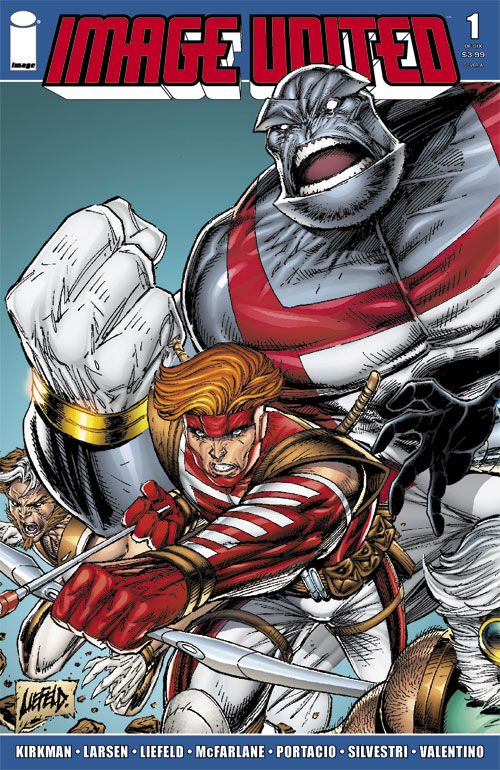In terms of a basic idea, the "Image United" mini-series is one that reaches high. Let relatively new Image Comics partner Robert Kirkman write a mini-series starring creations of six of the seven Image Comics founders, then have each founder draw their own character. Strictly from a logistical standpoint, it sounds like a nightmare to juggle all the pieces -- and, of course, the infamous 10th anniversary book (which only had four founders involved) was several years late. But, to everyone's credit, the first issue is here.
Like so many "event" books, this initial issue has to do all of the set-up. For a book starring two teams (Rob Liefeld's Youngblood and Marc Silvestri's CyberForce), plus four additional protagonists (Erik Larsen's Savage Dragon, Todd McFarlane's Spawn, Whilce Portacio's Fortress, and Jim Valentino's Shadowhawk), that's a lot of characters to juggle. So Robert Kirkman spends a lot of the issue just moving everyone onto the page, trying to get as many paths to converge as is logically possible. Due to Portacio's "Wetworks" series being owned by Wildstorm, Kirkman actually gets a small blessing by Portacio creating the new character Fortress for "Image United." It gives him a chance to have a character equally in the dark as everyone else, let him try and figure out what's going on even as the reader does the same.
That said, there's remarkably little actually happening in this first issue. Villains start attacking all over the country, and different heroes leap in to stop them. Elsewhere, the presumed uber-villain behind "Image United" reveals himself to a single character. And all the while, Fortress worries. I certainly hadn't expected a massively detailed first issue here, but it's a little slight in content. Unfortunately, I think I know what part of the problem is, and that's the art. Or rather, the way the art is set up.
All six Image founders involved in the book are drawing their own characters; one blurb on the Image Comics web site referred to the comic by saying, "Each page is an amazing jam piece!" That's both a good thing and a bad thing. Most of the pages that involve more than one creator come across as big, splashy spreads that let everyone involved showcase their own character. It's good for fans of the artists, but not so good for storytelling. The rare times that it feels like there's any sort of story progression are when it's just a single artist tackling an entire page. So when Larsen draws the Dragon going home, or McFarlane has the new Spawn discover the bad guy, things happen. There are multiple panels on the page, the story starts inching forward. Otherwise, though, it feels like a chance for each of the different artists to show off what they can do.
The funny thing is, some artists seem to be adapting their styles to fit in with the other artists on the page. Larsen draws the Dragon punching Overt-Kill (while Youngblood attacks as well) to match Liefeld's pencils when the two work together, while Larsen's solo page is more in his normal, blocky style. Likewise, Valentino's pencils of Shadowhawk with Liefeld's inks mesh so well I'd have guessed it was Liefeld drawing the entire page. It's an interesting end result, providing a more homogenous book than I'd have suspected. There aren't any surprises in the art, though; just about everyone still have their same strengths and weaknesses that you remember back when Image Comics began in 1992.
At the end of the day, "Image United" #1 comes across as a little dull more than anything else. Hopefully as the mini-series progresses, things will get rolling a bit more in terms of story. For people who came strictly for the art, there's certainly a lot to enjoy. If you were hoping for anything more than that, though, better luck next month. Writers were never quite as important when Image Comics first began, and Kirkman's contributions are definitely in the back seat for this first issue.

